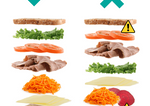Turn mindless eating into mindful meals
by Anne Finch, Accredited Practising Dietitian for LiveLighter
- May 3, 2016
- Leave a comment

Have you noticed if you’re eating in front of the TV, you can easily finish a whole plate of food without really tasting it? Or that drive-thru food scoffed in the car isn’t as satisfying as a meal eaten with proper cutlery?
There’s a lot of buzz around mindful eating these days. We’ll have a look at what it is and how it can help you eat better.
What is mindfulness?
Broadly, mindfulness is a form of self-awareness training. It’s a special way of paying attention, without judgement, to the things that are going on around you and also inside you. It’s kind of like meditation, and kind of like being a ninja.
Mindfulness has been used in a huge range of settings, including to train elite athletes and as part of treatment for anxiety and depression. It can help improve mental and physical health and is a pretty fun brain twisting exercise.
So how does it relate to food?
Mindful eating is really paying attention to your food, your senses and your body when you’re eating. Appreciating the colours, taste and textures of your food, savouring every mouthful. It’s about listening to your body’s hunger signals. Eating when you are hungry, enjoying your food and stopping before you are stuffed.
A lot of the eating we do is non-hungry eating. We eat when we’re in a rush, bored, stressed or sad. Or just because it’s there. Mindful eating can help us eat less, with more satisfaction. This can be an important thing to do if you’re looking to lose weight.
Research has found that being distracted while eating can lead to eating more, both at the time and later in the day. It shows that incorporating mindfulness and ‘attentive eating’ principles could help weight loss without the need for conscious calorie counting.
How can I do it?
Don’t worry, there’s an app to help! Below are a couple of resources and links I think are worth checking out:
- Smiling mind (free meditation app for young people)
- 7 mindful eating tips from the University Health Services at Berkeley
- Am I hungry? (a mindful eating training program)
- A Huffington Post article about mindful eating
Here are a few things to try at your next meal…
- No distractions. When you’re eating, that should be the only thing you’re doing. Get away from your desk, turn off the electronics and focus on the food you’re about to eat.
- Spend a little time with your food before you start wolfing it down. You don’t have to write your lunch a love song, but spend at least 15 seconds looking at it, arranging it on a plate, smelling it and imagining what it’s going to taste like. Think about where your food came from and how much work has gone into producing it.
- Eat like you’re at a posh restaurant. Take small bites, try and taste the individual flavours and think about how you’d describe the texture to your imaginary food critic dinner companion. Put your cutlery (or food) down every now and again. Chew well. Enjoy.
- Check in with your body. Are you full yet? On a sale of one to 10 (where one is starving hungry, and 10 is uncomfortably stuffed, food-coma-territory), you probably want to stop eating when you’re about a seven. You can pack up the rest of the food for later. YOU DON’T HAVE TO FINISH WHAT’S ON YOUR PLATE. I know it’s hard.
- Repeat. It’s probably not realistic to think that you’re going to prepare an attractive meal, lock the kids in another room, light candles and go full yogi at every meal. Set yourself a goal of doing this a few times a week to start with. It takes time and practice, so don’t beat yourself up if you’re not a super Zen master straight away. Anything is better than nothing, and a lot is better than a little. Do what you can!
Mindful eating is another tool to help you eat well and enjoy your food. Give it a try and let us know how you go! Here’s a quick exercise to help you get started (required: 3 minutes, internet, speakers/headphones and a sultana).
Consider this day in the life of… my friend*
7am: Toast eaten with one hand while running around finding keys, watering the garden and packing lunch.
10am: Oh hello, cookie jar that appeared overnight next to the kettle at work. Biscuit is finished on the walk between lunch room and desk.
12pm: Not hungry for lunch yet, but have to eat now or won’t get time to eat again before 3pm.
4pm: Hungry. Reach to emergency snacks in desk drawer. Scoff too many nuts while reading emails and feel a bit sick.
6.30pm: Eat straight off the chopping board while seasoning the stew for tonight’s dinner.
7pm: Eat dinner, but not really that hungry (see above).
8.30pm: I swear Malteaser packets are smaller than they used to be. Where did they all go?
Does any of this ring a bell? Reflecting on why and how you eat is an important part of mindful eating. The first step can be just laying it out like this for yourself. Try keeping a bit of a food diary, and including a section for a hunger rating or other notes about your meal (location, emotions etc).
*Definitely NOT me







